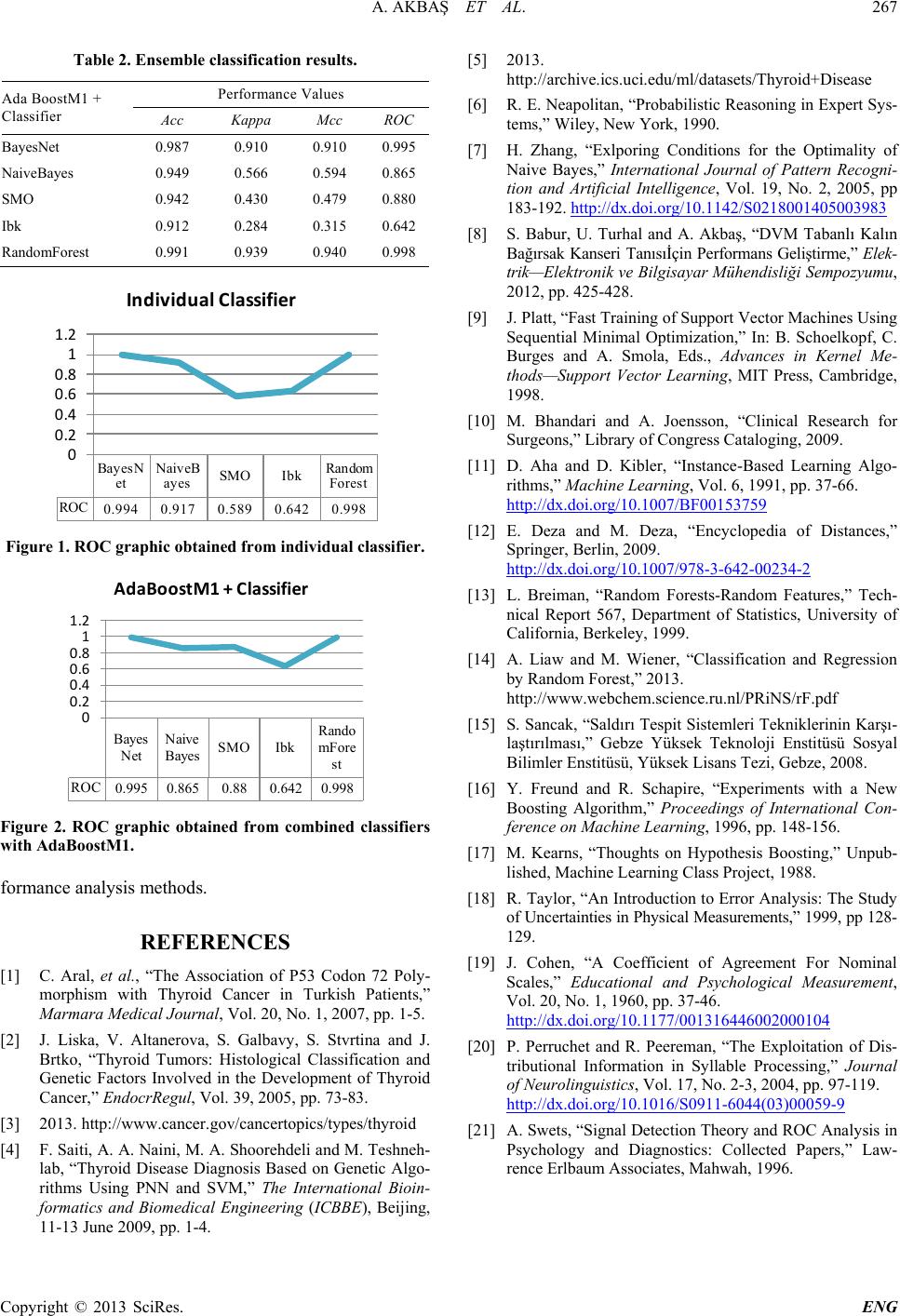
A. AKBAŞ ET AL.
Copyright © 2013 SciRes. ENG
Table 2. Ensemble classification results.
Ada BoostM1 +
Classif ie r
Performance Values
Acc Kappa Mcc ROC
BayesNet
0.987 0.910 0.910 0.995
NaiveBayes
0.949 0.566 0.594 0.865
SMO
0.942 0.430 0.479 0.880
Ibk
0.912 0.284 0.315 0.642
RandomForest
0.991 0.939 0.940 0.998
Figure 1. ROC graphic obtained from individual classifier.
Figure 2. ROC graphic obtained from combined classifiers
with AdaBoostM1.
formance analysis methods.
REFERENCES
[1] C. Aral, et al., “The Association of P53 Codon 72 Poly-
morphism with Thyroid Cancer in Turkish Patients,”
Marmara Medical Journal, Vol. 20, No. 1, 2007, pp. 1-5.
[2] J. Liska, V. Altanerova, S. Galbavy, S. Stvrtina and J.
Brtko, “Thyroid Tumors: Histological Classification and
Genetic Factors Involved in the Development of Thyroid
Cancer,” EndocrRegul, Vol. 39, 2005, pp. 73-83.
[3] 2013. http://www.cancer.gov/cancertopics/types/thyroid
[4] F. Saiti, A. A. Naini , M. A. Shoorehdeli and M. Teshneh-
lab, “Thyroid Disease Diagnosis Based on Genetic Algo-
rithms Using PNN and SVM,” The International Bioin-
formatics and Biomedical Engineering (ICBBE), Beijing,
11-13 June 2009, pp. 1-4.
[5] 2013.
http://archive.ics.uci.edu/ml/datasets/Thyroid+Disease
[6] R. E. Neapolitan, “Probabilistic Reasoning in Expert Sys-
tems,” Wiley, New York, 1990.
[7] H. Zhang, “Exlporing Conditions for the Optimality of
Naive Bayes,” International Journal of Pattern Recogni-
tion and Artificial Intelligence, Vol. 19, No. 2, 2005, pp
183-192. http://dx.doi.org/10.1142/S0218001405003983
[8] S. Babur, U. Turhal and A. Akbaş, “DVM Tabanlı Kalın
Bağırsak Kanseri Tanısıİçin Performans Geliştirme,” Elek-
trik—Elektronik ve Bilgisayar Mühendisliği Sempozyumu,
2012, pp. 425-428.
[9] J. Platt, “Fast Training of Support Vector Machines Using
Sequential Minimal Optimization,” In: B. Schoelkopf, C.
Burges and A. Smola, Eds., Advances in Kernel Me-
thods—Support Vector Learning, MIT Press, Cambridge,
1998.
[10] M. Bhandari and A. Joensson, “Clinical Research for
Surgeons,” Library of Congress Cataloging, 2009.
[11] D. Aha and D. Kibler, “Instance-Based Learning Algo-
rithms,” Machine Learning, Vol. 6, 1991, pp. 37-66.
http://dx.doi.org/10.1007/BF00153759
[12] E. Deza and M. Deza, “Encyclopedia of Distances,”
Springer, Berlin, 2009.
http://dx.doi.org/10.1007/978-3-642-00234-2
[13] L. Breiman, “Random Forests-Random Features,” Tech-
nical Report 567, Department of Statistics, University of
California, Berkeley, 1999.
[14] A. Liaw and M. Wiener, “Classification and Regression
by Random Forest,” 2013.
http://www.webchem.science.ru.nl/PRiNS/rF.pdf
[15] S. Sancak, “Saldırı Tespit Sistemleri Tekniklerinin Karşı-
laştırılması,” Gebze Yüksek Teknoloji Enstitüsü S osy a l
Bilimler Enstitüsü, Yüksek Lisans Tezi, Gebze, 2008.
[16] Y. Freund and R. Schapire, “Experiments with a New
Boosting Algorithm,” Proceedings of International Con-
ference on Machine Learning, 1996, pp. 148-156.
[17] M. Kearns, “Thoughts on Hypothesis Boosting,” Unpub-
lished, Machine Learning Class Project, 1988.
[18] R. Taylor, “An Introduction to Error Analysis: The Study
of Uncertainties in Physical Measurements,” 1999, pp 128-
129.
[19] J. Cohen, “A Coefficient of Agreement For Nominal
Scales,” Educational and Psychological Measurement,
Vol. 20, No. 1, 1960, pp. 37-46.
http://dx.doi.org/10.1177/001316446002000104
[20] P. Perruchet and R. Peereman, “The Exploitation of Dis-
tributional Information in Syllable Processing,” Journal
of Neurolinguistics, Vol. 17, No. 2-3, 2004, pp. 97-119.
http://dx.doi.org/10.1016/S0911-6044(03)00059-9
[21] A. Swets, “Signal Detect ion Theory and ROC Analysis in
Psychology and Diagnostics: Collected Papers,” Law-
rence Erlbaum Associates, Mahwah, 1996.